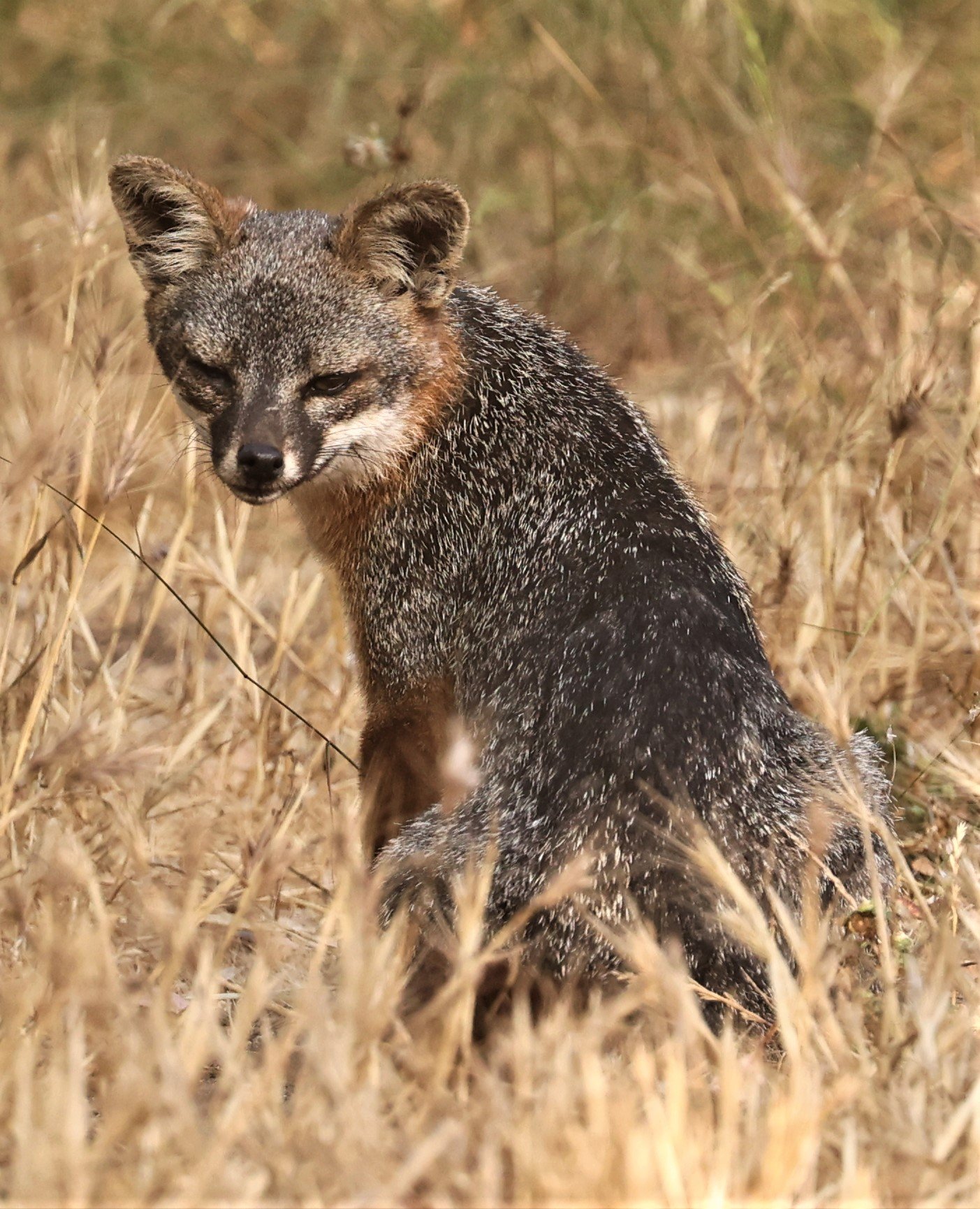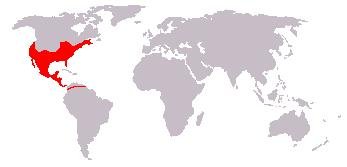
Urocyon (Greek) is a genus of Canidae which includes the gray fox (Urocyon cinereoargenteus) and the island fox (Urocyon littoralis).[2] These two fox species are found in the Western Hemisphere. Whole genome sequencing indicates that Urocyon is the most basal genus of the living canids.
The Island Fox (Urocyon littoralis) is a small fox that is endemic to six of the eight Channel Islands of California. There are six subspecies, each unique to the island it lives on, reflecting its evolutionary history. They are generally docile, show little fear of humans, and are easily tamed. Island foxes played an important role in the spiritual lives of native Channel Islanders. They have been likely semi-domesticated as pets, used as pelts, or for other functions, like pest control.
The skull of an island fox (right) compared with a skull of the related gray fox (left).
The island fox shares the genus Urocyon with the mainland gray fox (U. cinereoargenteus), the species from which it is descended. Its small size is a result of insular dwarfism, a form of allopatric speciation. Because the island fox is geographically isolated, it has not acquired immunity to parasites and diseases brought in from the mainland and is especially vulnerable to those that the domestic dog may carry. In addition, predation by the golden eagle (Aquila chrysaetos) and human activities devastated fox numbers on several of the Channel Islands in the 1990s. Four island fox subspecies were federally protected as an endangered species in 2004, and efforts to rebuild fox populations and restore the ecosystems of the Channel Islands are being undertaken. Radio collars are being attached to foxes in an effort to track and locate the young foxes. To date these efforts have been largely successful.
There are six subspecies of the island fox, each of which is native to a specific Channel Island, and which evolved there independently of the others. The subspecies are:
U. l. littoralis (the nominate subspecies) of San Miguel Island,
U. l. dickeyi of San Nicolas Island,
U. l. catalinae of Santa Catalina Island,
U. l. clementae of San Clemente Island,
U. l. santacruzae of Santa Cruz Island, and
U. l. santarosae of Santa Rosa Island.
Foxes from each island are capable of interbreeding, but have genetic and phenotypic distinctions that make them unique; for example, each subspecies has differing numbers of tail vertebrae.
The small size of the island fox is an adaptation to the limited resources available in the island environment, or island dwarfism. The foxes are believed to have "rafted" to the northern islands between 10,400 and 16,000 years ago. Initially, fox populations were located on the three northern islands, which were likely easier to access during the last ice age — when lowered sea levels united four of the northernmost islands into a single mega-island (Santa Rosae) and the distance between the islands and the mainland was reduced — it is likely that Native Americans brought the foxes to the southern islands of the archipelago, perhaps as pets, or hunting dogs.
Other names for the island fox include coast fox, short-tailed fox, island gray fox, Channel Islands fox, Channel Islands gray fox, California Channel Islands fox and insular gray fox.
The island fox is significantly smaller than the related gray fox, and is the smallest fox in North America, averaging slightly smaller than the swift (Vulpes velox) and kit foxes (Vulpes macrotis). Typically, the head-and-body length is 48–50 cm (19–19.5 in), shoulder height 12–15 cm (4.5–6 in), and the tail is 11–29 cm (4.5–11.5 in) long, which is notably shorter than the 27–44 cm (10.5–17.5 in) tail of the gray fox. This is due to the fact that the island fox generally has two fewer tail vertebrae than the gray fox. The island fox weighs between 1 and 2.8 kg (2.2 and 6.2 lb). The male is always larger than the female. The largest of the subspecies occurs on Santa Catalina Island and the smallest on Santa Cruz Island.
The island fox has gray fur on its head, a ruddy red coloring on its sides, white fur on its belly, throat and the lower half of its face, and a black stripe on the dorsal surface of its tail. In general the coat is darker and duller hued than that of the gray fox. The island fox molts once a year between August and November. Before the first molt pups are woolly and have a generally darker coat than adult foxes. A brown phase, with the grey and black fur of the body replaced by a sandy brown and a deeper brown, may occur in the San Clemente Island and San Nicolas Island populations. It is unclear if this is a true color phase, a change that occurs with age, or possibly a change that occurs because of interactions with Opuntia cactus spines that become embedded in the pelt.
The island fox typically forms monogamous breeding pairs, which are frequently seen together beginning in January and through the breeding season, from late February to early March. The gestation period is 50–63 days. The female island fox gives birth in a den, a typical litter having one to five pups, with an average of two or three. Pups are born in the spring and emerge from the den in early summer; the mother lactates for 7–9 weeks. Sexual maturity is reached at 10 months, and the females usually breed within the first year. Island foxes live for 4–6 years in the wild and for up to 8 years in captivity.
Its preferred habitat is complex layer vegetation with a high density of woody, perennially fruiting shrubs. The fox lives in all of the island biomes including temperate forest, temperate grassland and chaparral, with no island supporting more than 1,000 foxes. The island fox eats fruits, insects, birds, eggs, crabs, lizards, and small mammals, including deer mice. The fox tends to move around by itself, rather than in packs. It is generally nocturnal, although with peaks of activity at dawn and dusk. Activity also fluctuates with the season: It is more active during the day in summer than it is in winter.
The island fox is not intimidated by humans, although at first may show aggression. It is quite easy to tame and is generally docile. The island fox communicates using auditory, olfactory and visual signals. A dominant fox uses vocalizations, staring, and ear flattening to cause another fox to submit. Signs of dominance and submission are visual, such as facial expression and body posture. Its main vocalizations are barking and growling. The island fox marks territory with urine and feces.
Island (Gray) Fox (Urocyon littoralis santacruzae) - Several seen on Santa Cruz Island in Scorpion Campgrounds and visitor’s center





















































































































































The Gray Fox (Urocyon cinereoargenteus), or grey fox, is an omnivorous mammal of the family Canidae, widespread throughout North America and Central America. This species and its only congener, the diminutive island fox (Urocyon littoralis) of the California Channel Islands, are the only living members of the genus Urocyon, which is considered to be genetically basal to all other living canids. Its species name cinereoargenteus means "ashen silver".
It was once the most common fox in the eastern United States, and though still found there, human advancement and deforestation allowed the red fox to become the predominant fox-like canid. Despite this post-colonial competition, the gray fox has been able to thrive in urban and suburban environments, one of the best examples being southern Florida. The Pacific States and Great Lakes region still have the gray fox as their prevalent fox.
Yucatan Gray Fox (Urocyon cinereoargenteus fraterculus) - habituated individual in Cockscomb Jaguar Reserve, Belize

Gray Fox (Urocyon cinereoargenteus scottii) - all captive in the Sonoran Desert Museum in Arizona. I have seen this species in numerous locations over the years but have never been able to capture good images.







